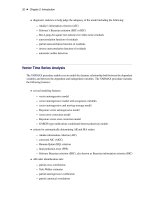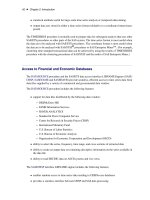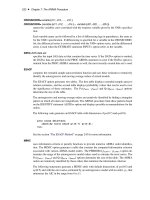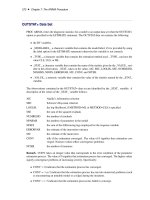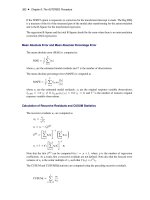SAS/ETS 9.22 User''''s Guide 158 pps
Bạn đang xem bản rút gọn của tài liệu. Xem và tải ngay bản đầy đủ của tài liệu tại đây (229.78 KB, 10 trang )
1562 ✦ Chapter 22: The SEVERITY Procedure (Experimental)
If left-truncation is specified and the MARKTRUNCATED option is specified, then the left-truncated
observations are marked in the plot. If right-censoring is specified and the MARKCENSORED
option is specified, then the right-censored observations are marked in the plot.
If regressor variables are specified, then the plotted CDF estimates are from a mixture distribution.
See the section “CDF and PDF Estimates with Regression Effects” on page 1545 for details.
Comparative PDF Plot
The comparative PDF plot helps you visually compare the probability density function (PDF)
estimates of all the candidate distribution models. The plot does not contain PDF estimates for
models whose parameter estimation process does not converge. The horizontal axis represents the
values of the response variable. The vertical axis represents the values of the PDF estimates.
If the HISTOGRAM option is specified, then the plot also contains the histogram of response variable
values. If the KERNEL option is specified, then the plot also contains the kernel density estimate for
the response variable values.
If regressor variables are specified, then the plotted PDF estimates are from a mixture distribution.
See the section “CDF and PDF Estimates with Regression Effects” on page 1545 for details.
PDF Plot per Distribution
The PDF plot per distribution shows the PDF estimates of each candidate distribution model unless
that model’s parameter estimation process does not converge. The horizontal axis represents the
values of the response variable. The vertical axis represents the values of the PDF estimates.
If the HISTOGRAM option is specified, then the plot also contains the histogram of response variable
values. If the KERNEL option is specified, then the plot also contains the kernel density estimate for
the response variable values.
If regressor variables are specified, then the plotted PDF estimates are from a mixture distribution.
See the section “CDF and PDF Estimates with Regression Effects” on page 1545 for details.
P-P Plot of CDF and EDF
The P-P plot of CDF and EDF is the probability-probability plot that compares the CDF estimates
of a distribution with the EDF estimates. A plot is not prepared for models whose parameter
estimation process does not converge. The horizontal axis represents the CDF estimates of a
candidate distribution and the vertical axis represents the EDF estimates.
This plot can be interpreted as displaying the data that is used for computing the EDF-based statistics
of fit for the given candidate distribution. As described in the section “EDF-Based Statistics” on
page 1550, these statistics are computed by comparing the EDF, denoted by
F
n
.y/
, and the CDF,
denoted by
F .y/
, at each of the response variable values
y
. Using the probability inverse transform
z D F.y/
, this is equivalent to comparing the EDF of the
z
, denoted by
F
n
.z/
, and the CDF of
z
,
denoted by
F .z/
(D’Agostino and Stephens 1986, Ch. 4). Given that the CDF of
z
is a uniform
Examples: SEVERITY Procedure ✦ 1563
distribution (
F .z/ D z
), the EDF-based statistics can be computed by comparing the EDF estimate
of
z
with the estimate of
z
. The horizontal axis of the plot represents the estimated CDF
Oz D
O
F .y/
.
The vertical axis represents the estimated EDF of
z
,
O
F
n
.z/
. The plot contains a scatter plot of
(Oz,
O
F
n
.z/)
points and a reference line
F
n
.z/ D z
that represents the expected uniform distribution
of
z
. Points scattered closer to the reference line indicate a better fit than the points scattered away
from the reference line.
If left-truncation is specified and the probability of observability is not specified, then the EDF
estimates are conditional as described in the section “EDF Estimates and Left-Truncation” on
page 1549. The displayed CDF estimates are also conditional estimates. If
O
F .y/
denotes an
unconditional estimate of the CDF at
y
and
t
min
is the smallest value of the left-truncation threshold,
then the conditional estimate of the CDF at y is
O
F
c
.y/ D .
O
F .y/
O
F .t
min
//=.1
O
F .t
min
//.
If regressor variables are specified, then the displayed CDF estimates, both unconditional and condi-
tional, are from a mixture distribution. See the section “CDF and PDF Estimates with Regression
Effects” on page 1545 for details.
Examples: SEVERITY Procedure
Example 22.1: Defining a Model for Gaussian Distribution
Suppose you want to fit a distribution model other than one of the predefined ones available to
you. Suppose you want to define a model for the Gaussian distribution with the following typical
parameterization of the PDF (f ) and CDF (F ):
f .xI; / D
1
p
2
exp
Â
.x /
2
2
2
Ã
F .xI; / D
1
2
Â
1 C erf
Â
x
p
2
ÃÃ
For PROC SEVERITY, a distribution model consists of a set of functions and subroutines that
are defined with the FCMP procedure. Each function and subroutine should be written following
certain rules. The details are provided in the section “Defining a Distribution Model with the FCMP
Procedure” on page 1519.
The following SAS statements define a distribution model named NORMAL for the Gaussian dis-
tribution. The OUTLIB= option in the PROC FCMP statement stores the compiled versions of
the functions and subroutines in the ‘models’ package of the WORK.SEVEXMPL library. The
LIBRARY= option in the PROC FCMP statement enables this PROC FCMP step to use the SVRTU-
TIL_RAWMOMENTS utility subroutine that is available in the SASHELP.SVRTDIST library. The
subroutine is described in the section “Predefined Utility Functions” on page 1537.
1564 ✦ Chapter 22: The SEVERITY Procedure (Experimental)
/
*
Define Normal Distribution with PROC FCMP
*
/
proc fcmp library=sashelp.svrtdist outlib=work.sevexmpl.models;
function normal_pdf(x,Mu,Sigma);
/
*
Mu : Location
*
/
/
*
Sigma : Standard Deviation
*
/
return ( exp(-(x-Mu)
**
2/(2
*
Sigma
**
2)) /
(Sigma
*
sqrt(2
*
constant('PI'))) );
endsub;
function normal_cdf(x,Mu,Sigma);
/
*
Mu : Location
*
/
/
*
Sigma : Standard Deviation
*
/
z = (x-Mu)/Sigma;
return (0.5 + 0.5
*
erf(z/sqrt(2)));
endsub;
subroutine normal_parminit(dim, x[
*
], nx[
*
], F[
*
], Mu, Sigma);
outargs Mu, Sigma;
array m[2] / nosymbols;
/
*
Compute estimates by using method of moments
*
/
call svrtutil_rawmoments(dim, x, nx, 2, m);
Mu = m[1];
Sigma = sqrt(m[2] - m[1]
**
2);
endsub;
subroutine normal_lowerbounds(Mu, Sigma);
outargs Mu, Sigma;
Mu = .; /
*
Mu has no lower bound
*
/
Sigma = 0; /
*
Sigma > 0
*
/
endsub;
quit;
The statements define the two functions required of any distribution model (NORMAL_PDF
and NORMAL_CDF) and two optional subroutines (NORMAL_PARMINIT and NOR-
MAL_LOWERBOUNDS). The name of each function or subroutine must follow a specific
structure. It should start with the model’s short or identifying name, which is ‘NORMAL’ in this
case, followed by an underscore ‘_’, followed by a keyword suffix such as ‘PDF’. Each function or
subroutine has a specific purpose. The details of all the functions and subroutines that you can define
for a distribution model are provided in the section “Defining a Distribution Model with the FCMP
Procedure” on page 1519. Following is the description of each function and subroutine defined in
this example:
The PDF and CDF suffixes define functions that return the probability density function and
cumulative distribution function values, respectively, given the values of the random variable
and the distribution parameters.
The PARMINIT suffix defines a subroutine that returns the initial values for the parameters by
using the sample data or the empirical distribution function (EDF) estimate computed from it.
In this example, the parameters are initialized by using the method of moments. Hence, you
do not need to use the EDF estimates, which are available in the F array. The first two raw
Example 22.1: Defining a Model for Gaussian Distribution ✦ 1565
moments of the Gaussian distribution are as follows:
EŒx D ; EŒx
2
D
2
C
2
Given the sample estimates,
m
1
and
m
2
, of these two raw moments, you can solve the equations
EŒx D m
1
and
EŒx
2
D m
2
to get the following estimates for the parameters:
O D m
1
and
O D
q
m
2
m
2
1
. The NORMAL_PARMINIT subroutine implements this solution. It uses
the SVRTUTIL_RAWMOMENTS utility subroutine to compute the first two raw moments.
The LOWERBOUNDS suffix defines a subroutine that returns the lower bounds on the pa-
rameters. PROC SEVERITY assumes a default lower bound of 0 for all the parameters when
a LOWERBOUNDS subroutine is not defined. For the parameter
(Mu), there is no lower
bound, so you need to define the NORMAL_LOWERBOUNDS subroutine. It is recommended
that you assign bounds for all the parameters when you define the LOWERBOUNDS subrou-
tine or its counterpart, the UPPERBOUNDS subroutine. Any unassigned value is returned
as a missing value, which is interpreted by PROC SEVERITY to mean that the parameter is
unbounded, and that might not be what you want.
You can now use this distribution model with PROC SEVERITY. Let the following DATA step
statements simulate a normal sample with D 10 and D 2:5.
/
*
Simulate a Normal sample
*
/
data testnorm(keep=y);
call streaminit(12345);
do i=1 to 100;
y = rand('NORMAL', 10, 2.5);
output;
end;
run;
Prior to using your distribution with PROC SEVERITY, you must communicate the location of the
library that contains the definition of the distribution and the locations of libraries that contain any
functions and subroutines used by your distribution model. The following OPTIONS statement sets
the CMPLIB= system option to include the FCMP library WORK.SEVEXMPL in the search path
used by PROC SEVERITY to find FCMP functions and subroutines.
/
*
Set the search path for functions defined with PROC FCMP
*
/
options cmplib=(work.sevexmpl);
Now, you are ready to fit the NORMAL distribution model with PROC SEVERITY. The following
statements fit the model to the values of Y in the WORK.TESTNORM data set:
/
*
Fit models with PROC SEVERITY
*
/
proc severity data=testnorm print=all;
model y;
dist Normal;
run;
The DIST statement specifies the identifying name of the distribution model, which is ‘NORMAL’.
Neither is the INEST= option specified in the PROC SEVERITY statement nor is the INIT= option
specified in the DIST statement. So, PROC SEVERITY initializes the parameters by invoking the
NORMAL_PARMINIT subroutine.
1566 ✦ Chapter 22: The SEVERITY Procedure (Experimental)
Some of the results prepared by the preceding PROC SEVERITY step are shown in Output 22.1.1
and Output 22.1.2. The descriptive statistics of variable Y and the model selection table, which
includes just the normal distribution, are shown in Output 22.1.1.
Output 22.1.1 Summary of Results for Fitting the Normal Distribution
The SEVERITY Procedure
Input Data Set
Name WORK.TESTNORM
Descriptive Statistics for Variable y
Number of Observations 100
Number of Observations Used for Estimation 100
Minimum 3.88249
Maximum 16.00864
Mean 10.02059
Standard Deviation 2.37730
Model Selection Table
Distribution Converged -2 Log Likelihood Selected
Normal Yes 455.97541 Yes
The initial values for the parameters, the optimization summary, and the final parameter estimates are
shown in Output 22.1.2. No iterations are required to arrive at the final parameter estimates, which
are identical to the initial values. This confirms the fact that the maximum likelihood estimates for
the Gaussian distribution are identical to the estimates obtained by the method of moments that was
used to initialize the parameters in the NORMAL_PARMINIT subroutine.
Output 22.1.2 Details of the Fitted Normal Distribution Model
The SEVERITY Procedure
Distribution Information
Name Normal
Number of Distribution Parameters 2
Initial Parameter Values and Bounds
for Normal Distribution
Initial Lower Upper
Parameter Value Bound Bound
Mu 10.02059 -Infty Infty
Sigma 2.36538 1.05367E-8 Infty
Example 22.2: Defining a Model for Gaussian Distribution with a Scale Parameter ✦ 1567
Output 22.1.2 continued
Optimization Summary for Normal Distribution
Optimization Technique Trust Region
Number of Iterations 0
Number of Function Evaluations 2
Log Likelihood -227.98770
Parameter Estimates for Normal Distribution
Standard Approx
Parameter Estimate Error t Value Pr > |t|
Mu 10.02059 0.23894 41.94 <.0001
Sigma 2.36538 0.16896 14.00 <.0001
The NORMAL distribution defined and illustrated here has no scale parameter, because all the
following inequalities are true:
f .xI; / ¤
1
f .
x
I1; /
f .xI; / ¤
1
f .
x
I; 1/
F .xI; / ¤ F.
x
I1; /
F .xI; / ¤ F.
x
I; 1/
This implies that you cannot estimate the effect of regressors on a model for the response variable
based on this distribution.
Example 22.2: Defining a Model for Gaussian Distribution with a Scale
Parameter
If you want to estimate the effects of regressors, then the model needs to be parameterized to have a
scale parameter. While this might not be always possible, for the case of the Gaussian distribution it
is possible by replacing the location parameter
with another parameter,
˛ D =
, and defining the
PDF (f ) and the CDF (F ) as follows:
f .xI; ˛/ D
1
p
2
exp
Â
1
2
x
˛
Á
2
Ã
F .xI; ˛/ D
1
2
Â
1 C erf
Â
1
p
2
x
˛
Á
ÃÃ
1568 ✦ Chapter 22: The SEVERITY Procedure (Experimental)
It can be verified that is the scale parameter, because both of the following equalities are true:
f .xI; ˛/ D
1
f .
x
I1; ˛/
F .xI; ˛/ D F .
x
I1; ˛/
The following statements use this parameterization to define a new model named NORMAL_S. The
definition is stored in the WORK.SEVEXMPL library.
/
*
Define Normal Distribution With Scale Parameter
*
/
proc fcmp library=sashelp.svrtdist outlib=work.sevexmpl.models;
function normal_s_pdf(x, Sigma, Alpha);
/
*
Sigma : Scale & Standard Deviation
*
/
/
*
Alpha : Scaled mean
*
/
return ( exp(-(x/Sigma - Alpha)
**
2/2) /
(Sigma
*
sqrt(2
*
constant('PI'))) );
endsub;
function normal_s_cdf(x, Sigma, Alpha);
/
*
Sigma : Scale & Standard Deviation
*
/
/
*
Alpha : Scaled mean
*
/
z = x/Sigma - Alpha;
return (0.5 + 0.5
*
erf(z/sqrt(2)));
endsub;
subroutine normal_s_parminit(dim, x[
*
], nx[
*
], F[
*
], Sigma, Alpha);
outargs Sigma, Alpha;
array m[2] / nosymbols;
/
*
Compute estimates by using method of moments
*
/
call svrtutil_rawmoments(dim, x, nx, 2, m);
Sigma = sqrt(m[2] - m[1]
**
2);
Alpha = m[1]/Sigma;
endsub;
subroutine normal_s_lowerbounds(Sigma, Alpha);
outargs Sigma, Alpha;
Alpha = .; /
*
Alpha has no lower bound
*
/
Sigma = 0; /
*
Sigma > 0
*
/
endsub;
quit;
An important point to note is that the scale parameter Sigma is the first distribution parameter (after
the ‘x’ argument) listed in the signatures of NORMAL_S_PDF and NORMAL_S_CDF functions.
Sigma is also the first distribution parameter listed in the signatures of other subroutines. This is
required by PROC SEVERITY, so that it can identify which is the scale parameter. When regressor
variables are specified, PROC SEVERITY checks whether the first parameter of each candidate
distribution is a scale parameter (or a log-transformed scale parameter if SCALETRANSFORM
subroutine is defined for the distribution with LOG as the transform). If it is not, then an appropriate
message is written the SAS log and that distribution is not fitted.
Example 22.2: Defining a Model for Gaussian Distribution with a Scale Parameter ✦ 1569
Let the following DATA step statements simulate a sample from the normal distribution where the
parameter is affected by the regressors as follows:
D exp.1 C 0:5 X1 C 0:75 X3 2 X4 C X5/
The sample is simulated such that the regressor X2 is linearly dependent on regressors X1 and X3.
/
*
Simulate a Normal sample affected by Regressors
*
/
data testnorm_reg(keep=y x1-x5 Sigma);
array x{
*
} x1-x5;
array b{6} _TEMPORARY_ (1 0.5 . 0.75 -2 1);
call streaminit(34567);
label y='Normal Response Influenced by Regressors';
do n = 1 to 100;
/
*
simulate regressors
*
/
do i = 1 to dim(x);
x(i) = rand('UNIFORM');
end;
/
*
make x2 linearly dependent on x1 and x3
*
/
x(2) = x(1) + 5
*
x(3);
/
*
compute log of the scale parameter
*
/
logSigma = b(1);
do i = 1 to dim(x);
if (i ne 2) then
logSigma = logSigma + b(i+1)
*
x(i);
end;
Sigma = exp(logSigma);
y = rand('NORMAL', 25, Sigma);
output;
end;
run;
The following statements use PROC SEVERITY to fit the NORMAL_S distribution model along
with some of the predefined distributions to the simulated sample:
/
*
Set the search path for functions defined with PROC FCMP
*
/
options cmplib=(work.sevexmpl);
/
*
Fit models with PROC SEVERITY
*
/
proc severity data=testnorm_reg print=all plots=none;
model y=x1-x5;
dist Normal_s;
dist burr;
dist logn;
dist pareto;
dist weibull;
run;
1570 ✦ Chapter 22: The SEVERITY Procedure (Experimental)
The model selection table prepared by PROC SEVERITY is shown in Output 22.2.1. It indicates
that all the models, except the Burr distribution model, have converged. Also, only three models,
Normal_s, Burr, and Weibull, seem to have a good fit for the data. The table that compares all the
fit statistics indicates that Normal_s model is the best according to the likelihood-based statistics;
however, the Burr model is the best according to the EDF-based statistics.
Output 22.2.1 Summary of Results for Fitting the Normal Distribution with Regressors
The SEVERITY Procedure
Input Data Set
Name WORK.TESTNORM_REG
Model Selection Table
Distribution Converged -2 Log Likelihood Selected
Normal_s Yes 603.95786 Yes
Burr Maybe 612.80861 No
Logn Yes 749.20125 No
Pareto Yes 841.07013 No
Weibull Yes 612.77496 No
All Fit Statistics Table
-2 Log
Distribution Likelihood AIC AICC BIC KS
Normal_s 603.95786
*
615.95786
*
616.86108
*
631.58888
*
1.56822
*
Burr 612.80861 626.80861 628.02600 645.04480 1.59005
Logn 749.20125 761.20125 762.10448 776.83227 2.89985
Pareto 841.07013 853.07013 853.97336 868.70115 4.83826
Weibull 612.77496 624.77496 625.67819 640.40598 1.59176
All Fit Statistics Table
Distribution AD CvM
Normal_s 4.25257 0.75658
Burr 4.21979
*
0.71880
*
Logn 16.57630 3.13174
Pareto 31.60773 6.84091
Weibull 4.22441 0.71985
This prompts for further evaluation of why the model with Burr distribution has not converged.
The initial values, convergence status, and the optimization summary for the Burr distribution are
shown in Output 22.2.2. The initial values table indicates that the regressor X2 is redundant, which is
expected. More importantly, the convergence status indicates that it requires more than 50 iterations.
PROC SEVERITY enables you to change several settings of the optimizer by using the NLOPTIONS
statement. In this case, you can increase the limit of 50 on the iterations, change the convergence
criterion, or change the technique to something other than the default trust-region technique.
Example 22.2: Defining a Model for Gaussian Distribution with a Scale Parameter ✦ 1571
Output 22.2.2 Details of the Fitted Burr Distribution Model
The SEVERITY Procedure
Distribution Information
Name Burr
Description Burr Distribution
Number of Distribution Parameters 3
Number of Regression Parameters 4
Initial Parameter Values and
Bounds for Burr Distribution
Initial Lower Upper
Parameter Value Bound Bound
Theta 25.75198 1.05367E-8 Infty
Alpha 2.00000 1.05367E-8 Infty
Gamma 2.00000 1.05367E-8 Infty
x1 0.07345 -709.78271 709.78271
x2 Redundant . .
x3 -0.14056 -709.78271 709.78271
x4 0.27064 -709.78271 709.78271
x5 -0.23230 -709.78271 709.78271
Convergence Status for Burr Distribution
Needs more than 50 iterations.
Optimization Summary for Burr Distribution
Optimization Technique Trust Region
Number of Iterations 50
Number of Function Evaluations 130
Log Likelihood -306.40430
The following PROC SEVERITY step uses the NLOPTIONS statement to change the convergence
criterion and the limits on the iterations and function evaluations, exclude the lognormal and Pareto
distributions that have been confirmed previously to fit the data poorly, and exclude the redundant
regressor X2 from the model:
/
*
Enable ODS graphics processing
*
/
ods graphics on;
/
*
Refit and compare models with higher limit on iterations
*
/
proc severity data=testnorm_reg print=all plots=pp;
model y=x1 x3-x5;
dist Normal_s;
dist burr;
dist weibull;
nloptions absfconv=2.0e-5 maxiter=100 maxfunc=500;
run;
